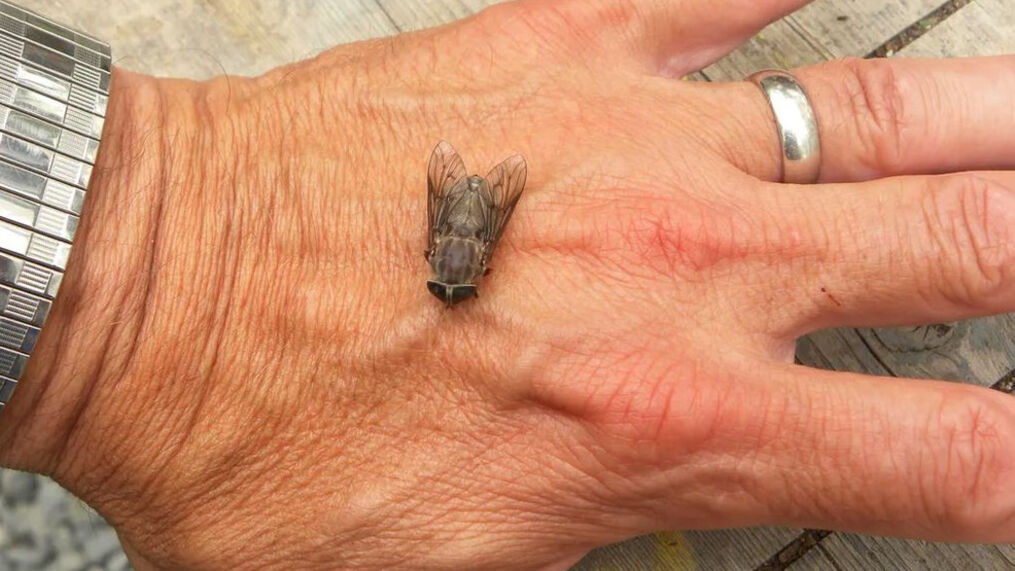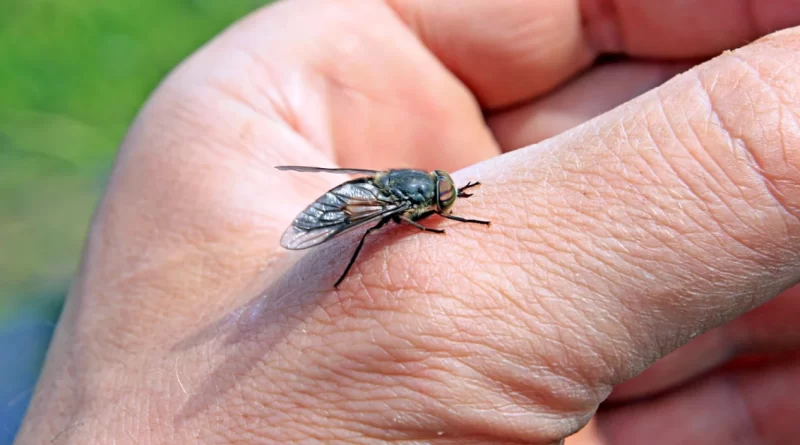What is Horse Fly Bite? What are Symptoms, Preventions, and Treatment?
What is a Horse Fly?
Horse flies are large insects. They have solid wings and bright eyes. Their bodies are dark or gray.
Horse flies are usually found near water. They are most active on hot, humid days. The larvae feed on minnows and small animals.
There are four stages of the horse fly’s life cycle. They are larvae, pupae, adults, and eggs. In the egg stage, the female flies deposit their eggs on wet soil.
The larvae are similar to the maggots found in house flies. Some species of the horse fly continue to develop in the larvae stage for several years. These flies can cause discomfort and even a painful bite to humans and animals.
Female horse flies will bite you aggressively, so be careful when getting into a pond or a wading pool. When bitten, avoid scratching the wound. This will increase the risk of infection and can make the bite worse.
The body of a horse fly is about half an inch in length. It has a gray or black body with horizontal stripes. However, some species have completely black wings.
Male flies have weak eyes and well-developed mouthparts. Typically, males congregate in groups where females frequent. Unlike other flies, horseflies are not afraid of people.
Depending on the species, horseflies can spread a number of diseases. Horseflies are known to carry anaplasmosis, tularemia, and equine infectious anemia.
A horsefly’s bite is not dangerous but can cause a large rash, swelling, and itchiness. You can take over-the-counter medications to help relieve the itching and sting of a horsefly bite. If you experience wheezing or difficulty breathing symptoms, seek immediate medical care.
How to Identify Horse Fly Bite?

Horseflies are a type of insect that can bite humans and animals. While horseflies do not cause disease, they can interfere with animal grazing and can harm livestock.
Because of the way their mouthparts are structured, horseflies make a very painful bite. The bite may cause swelling, redness, itching and welts. Some people even develop an allergic reaction to the bite.
If you get bitten by a horsefly, you should treat the bite as you would any other insect bite. This means that you should wash the area, apply antiseptics and avoid scratching the wound.
Scratching a horsefly bite can make the injury worse. It can also increase the risk of bacterial infection. You should also seek medical attention if the symptoms of the infection become serious.
When a horsefly bites, it cuts the skin in a scissors-like manner. However, this type of bite is not as serious as other types of bites.
Over-the-counter medications can help with itching, including creams, lotions and ointments. You can also take prescription medications.
You should see a doctor immediately if you are experiencing severe pain, dizziness, breathing problems, or bleeding from the bite. A doctor may prescribe antibiotics for a horsefly bite.
If you notice that the bite has changed, you should contact a licensed pest control professional. Your doctor might also suggest an epinephrine pen.
As with any other insect bite, you should not scratch the area. This increases the risk of infection and can lead to blisters and other complications.
What Do Horse Flies Look Like?

Horse flies are one of the largest flies in the world, and they are also notorious for their painful bites. These insects are particularly common during the summer months. They can cause economic damage to livestock, and they can spread pathogens. However, their biology makes them very hard to control.
Horse flies are typically black or gray, with large, colorful eyes. They are stout-bodied and have six legs. A male fly has a small head and antennae, while a female has a head with a large mouthpart. The mouthparts are used to feed on blood.
Females lay eggs on the undersides of leaves or vegetation. The larvae are about half an inch long, with a strong hook-like mouthpart. There are about ten to thirty larvae on a single egg. After hatching, the larvae begin feeding on small organisms in the water and decaying organic matter.
These flies are attracted to damp areas during the spring and summer and usually settle in a pond. However, in some cases, they are found in wetlands, forests, and marshes.
Adult horseflies are generally about 3/4 to 1 1/4 inches long, with often translucent or transparent wings. They are also quite hairy. Some species have dark wings.
Unlike mosquitoes, which suck blood through their mouthparts, horse flies use specialized mouthparts to feed on their prey. They track their prey by color and smell, often following the source of carbon dioxide exhaled by their target.
Is a Horse Fly Bite Dangerous for You?
Horseflies are a group of insects that are often found near water. They are usually harmless to humans but can cause an allergic reaction or infection. If a horsefly has bitten you, it is important to seek medical advice.
A horsefly bite is a painful and itchy skin injury. It is possible for a bite to become infected, so it’s important to treat it immediately. Treatments for a horsefly bite include cleansing the wound with an antiseptic, reducing inflammation and pain, and applying an ice pack to the area to reduce swelling.
Some people have a serious allergic reaction to horseflies. This can lead to hives, wheezing, and even dizziness. These symptoms are a sign of an allergic reaction and require immediate medical treatment.
Horseflies can also spread diseases, such as tularemia. Also called rabbit fever, tularemia is a dangerous bacterial infection. It can be treated with antibiotics.
If unsure whether a bite is from a horsefly, take your clothes off and check the area. You might notice a red lump or bump.
Scratching the area can make the bite worse. If you scratch it, you may risk spreading a bacterial infection to the surrounding area.
A horsefly bite can be difficult to distinguish from other types of insect bites. In addition, a horsefly bite is often more painful than a mosquito bite. The area will turn red and blister, and the wound may be inflamed.
Symptoms of Serious Horse Fly Reactions
A horsefly bite can be quite painful and can cause infection. It is important to seek treatment as soon as possible to prevent further harm. Some of the symptoms of a serious horse fly reaction include swelling, redness, wheezing, and breathing problems.
If you are unsure whether you have an allergic reaction, you can take a skin test. This will determine the exact type of allergy that you have.
After the bite is healed, avoiding areas where flies are active is best. These insects can carry bacterial agents and other parasites that can be harmful. They can also interfere with grazing animals.
To avoid getting bitten by horseflies, use insect repellents. These are available over the counter and provide protection against these and other pests.
You should also wash the wound after you have been bitten. The use of antiseptics can help to clear up any wounds. Also, icing the wound will reduce the pain and swelling.
Scratching the area can lead to open sores and infections. Ensure that you do not scratch the horsefly bite. Instead, apply a cold compress to the affected area.
While most fly allergies are mild, a few species can cause serious allergic reactions. Symptoms of a severe allergic reaction can include hives, dizziness, or swelling around the eyes.
You can apply an antihistamine cream or ointment to treat an allergic reaction. Other treatments include topical antibiotics. For more intense cases, corticosteroids or long-acting intramuscular steroids may be recommended.
Treatment of Horse Fly Bite?
If a horsefly has ever bitten you, you know that the bite is painful and can cause infections. However, there are steps you can take to help the bite heal. You might even want to see a doctor.
When you first get bitten, it’s important to avoid scratching the wound. Scratching can lead to infection. Instead, try to ice the wound. Ice will reduce the pain and swelling.
The best treatment for a horsefly bite is to see a veterinarian. Your vet will evaluate the symptoms, examine the skin, and look for parasites and allergens. They may also perform a skin biopsy.
Depending on the severity of the wound, you may need to use antibiotics. It’s also possible to receive a topical steroid to help relieve the itch.
Unlike most insect bites, the symptoms of a horsefly bite will not appear immediately after the bite. Usually, the pain and swelling will subside within a few days. However, seek medical attention if you notice more serious symptoms, like redness, wheezing, or difficulty breathing.
Treating a horsefly bite is similar to treating any other type of insect sting. You can clean the bite with antiseptic soap and water if the bite is not painful.
You may be prescribed an intramuscular steroid or allergy shots for severe cases of fly bite hypersensitivity. While these drugs will provide relief, they may not be enough.
Besides the traditional antiseptics, you can apply other remedies such as hydrocortisone cream. Saliva contains histatin protein, which has healing properties.
Preventions From Horse Fly Bite
You may find it painful and infected when you get bitten by horse flies. It’s important to know how to prevent and treat it.
You should always avoid scratching the wound. Scratching increases the risk of infection. A cold compress is also helpful. If you have a fever, call a doctor.
Horse flies can carry pathogens that can cause dangerous diseases. In the case of an allergic reaction, the bite can be life-threatening.
The best way to prevent bites is to wear light colors. This will help keep flies from noticing you. Also, use an insect repellent with 50% DEET. These repellents are more effective than those with lesser amounts of DEET.
Some home remedies can be used to cure a horsefly bite. Some include baking soda, vinegar, or rubbing an ice pack on the affected area.
Antiseptics are also helpful in treating a horsefly bite. The antiseptic solution will keep the wound clean. For more severe cases, antihistamines can be prescribed.
It’s also a good idea to use an ice pack to reduce swelling and pain. To keep the skin clean, wash the wound with soap and water and then apply a cool salt water saline solution.
If you’re allergic to flies, you should use an antihistamine or a corticosteroid. In the case of anaphylaxis, you should seek medical attention immediately.
Using a hat or protective clothing, you can help protect your skin from a horsefly bite. You should also avoid perfumed cosmetics.
Suppose you are passionate about writing about Health topics. You can search “Write for Us Health” in search engines. We’ll welcome you to write for us.

